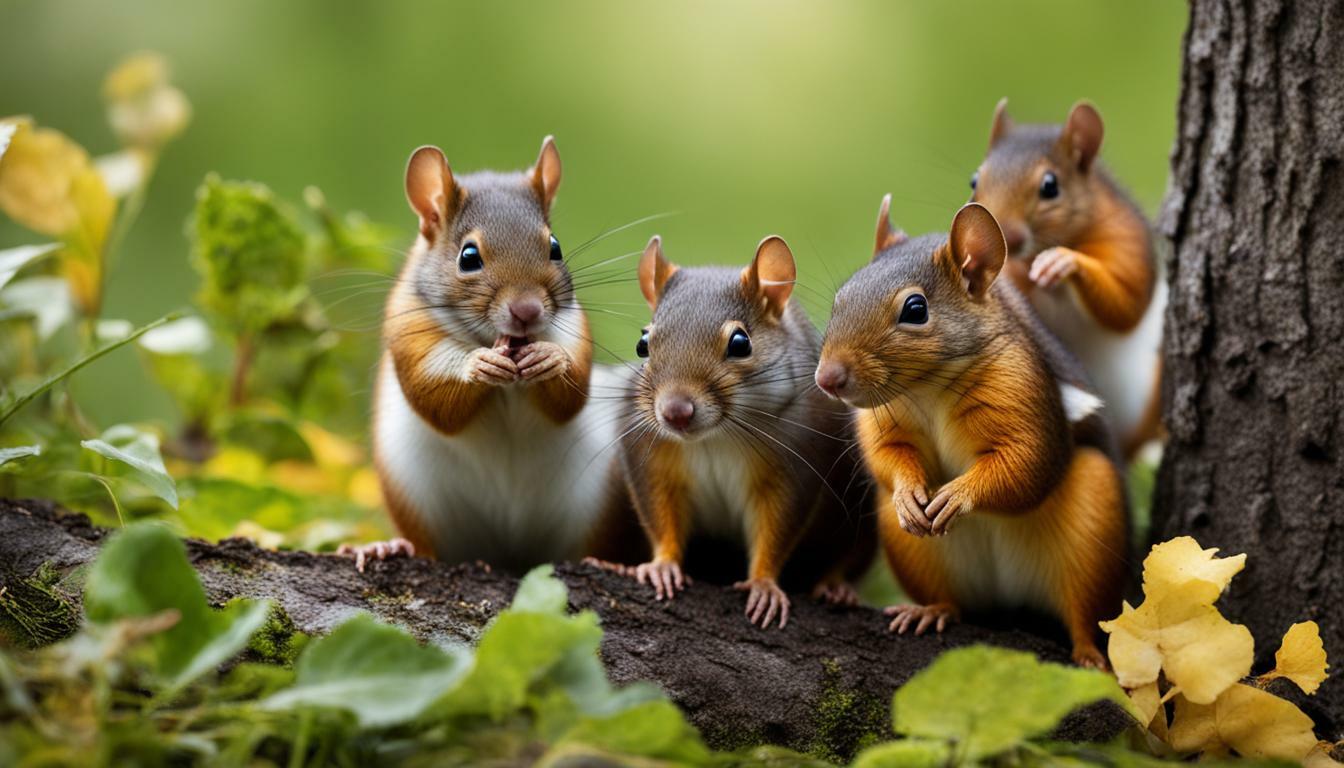Rats and squirrels are both common rodents, but can they really live together peacefully in the same environment?
Key Takeaways:
- Rats and squirrels have different living environments, with squirrels primarily living in trees and rats living in burrows or easily accessed houses.
- Squirrels rely more on natural produce and nuts for food, while rats are scavengers and have a broader diet.
- Rats and squirrels rarely interact with each other and do not view each other as significant threats.
- In extreme cases of food shortage, squirrels may kill and eat rats, but this is not the norm.
- Rats and squirrels can coexist as long as they have enough food and space, but it is important to separate them if any signs of hostility are observed.
Habitat Differences Between Rats and Squirrels
Rats and squirrels have different preferences when it comes to their living spaces, which can affect their ability to coexist. Squirrels are arboreal creatures, meaning they primarily live in trees. They build nests, or dreys, high up in the branches, where they feel safe and secure. Squirrels are agile climbers and spend most of their time in the treetops, foraging for food and sheltering from predators. On the other hand, rats are burrowers and prefer to live underground or in easily accessible houses. They create complex systems of burrows and tunnels, providing them with protection and a place to raise their young. Rats are adaptable and can make themselves at home in urban environments as well, often taking up residence in buildings or garages.
These differing habitat preferences can make it challenging for rats and squirrels to coexist in the same space. Squirrels primarily occupy the treetops, while rats prefer to be closer to the ground. This separation reduces the chances of direct encounters between the two species. However, there are instances where their habitats may overlap, such as when squirrels have nests in trees near buildings or rats find their way into homes or gardens.
To better understand the habitat differences, let’s take a look at a comparison table:
| Rats | Squirrels |
|---|---|
| Burrowers | Arboreal |
| Ground dwellers | Treetop inhabitants |
| Adaptable to urban environments | Prefer natural habitats |
| Can take up residence in buildings | Build nests in trees |
As we can see, these differences in habitat preference can influence the likelihood of rats and squirrels sharing the same space. While it is not impossible for them to coexist, it is important to consider and manage their habitats to reduce the chances of conflicts arising between them.
Varied Feeding Preferences
Rats and squirrels have different dietary preferences, which can impact their ability to share resources. Squirrels primarily rely on natural produce such as fruits, nuts, and seeds. Their sharp incisors enable them to crack open nuts and access the nutritious contents. In contrast, rats are scavengers and have a more diverse diet. They will eat almost anything, including garbage, grains, and even other animals.
These varied feeding habits can pose challenges when rats and squirrels inhabit the same area. Squirrels may struggle to protect their food sources from rats, who are opportunistic and will compete for available resources. This can create tensions between the two species, as both are driven by their instinct to survive and secure enough sustenance.
To better understand the compatibility of rats and squirrels in terms of their feeding preferences, consider the following table:
| Squirrels | Rats |
|---|---|
| Primarily consume nuts and natural produce | Scavengers who eat a wide range of food, including garbage |
| Use sharp incisors to crack open nuts | Adapted to gnawing and chewing on various materials |
| Prefer fresh fruits and vegetables | Capable of consuming decaying or spoiled food |
It’s important to note that while rats and squirrels may have different dietary preferences, they can still coexist if there is enough food and space available for both species. However, if you observe any signs of hostility or aggressive behavior between rats and squirrels, it is advisable to separate them immediately to prevent any potential harm to either species. By understanding their differences and taking the necessary precautions, you can ensure a more harmonious coexistence between rats and squirrels.
Limited Interactions Between Rats and Squirrels
Despite sharing the same environment, rats and squirrels tend to keep to themselves and do not engage in regular interactions. Their distinct living habits and feeding preferences contribute to their limited interactions.
Rats are known for residing in burrows or easily accessible houses, while squirrels primarily make their homes in trees. These habitat differences naturally create physical barriers that prevent frequent encounters between the two species.
Furthermore, rats are scavengers and will eat almost anything, while squirrels have a preference for natural produce and nuts. Their varied feeding habits reduce the likelihood of competition for food resources, which further limits their interactions.
It is important to note that while rats and squirrels generally coexist peacefully, there may be instances of hostility. In cases of extreme food shortage, squirrels have been observed killing and eating rats. However, such occurrences are rare and should not be the basis for generalizing their behavior.
| Rats | Squirrels |
|---|---|
| Reside in burrows or accessible houses | Primarily inhabit trees |
| Scavengers | Rely on natural produce and nuts |
| Rarely interact with squirrels | Rarely interact with rats |
| No significant threat perception | No significant threat perception |
In conclusion, while rats and squirrels may share the same environment, they do not form close relationships or engage in regular interactions. Their different living habits and feeding preferences contribute to their limited encounters. As long as they have enough food and space, rats and squirrels can coexist without major issues. It is advisable to separate them immediately if any signs of hostility are observed.
Extreme Circumstances: Squirrels Killing Rats
In situations of severe food scarcity, squirrels may resort to predatory behavior towards rats, but this is an unusual occurrence. It’s important to note that this behavior is not typical for squirrels and should not be seen as the norm in their interactions with rats. Squirrels are primarily herbivores, relying on a diet of natural produce and nuts.
However, when faced with extreme hunger and limited resources, squirrels may display a predatory instinct. This means that they may kill and consume rats as a means of survival. It’s worth mentioning that this scenario is rare and does not reflect the typical dynamics between rats and squirrels.
To emphasize, rats and squirrels are not known to actively seek out each other as prey or enemies in their natural habitats. They do not view each other as significant threats and, therefore, do not engage in frequent interactions. Their differing habitat preferences and feeding habits contribute to their limited contact.
In summary, while squirrels killing rats can occur in extreme circumstances, it is an uncommon event. Rats and squirrels are more likely to coexist peacefully as long as they have enough food and space. It is important to be observant of any signs of hostility between them and take immediate action to separate them if necessary.
Coexistence with Enough Food and Space
Rats and squirrels can peacefully coexist if their basic needs for food and space are adequately met. Understanding the factors that contribute to their cohabitation can help create an environment where both species can thrive.
When it comes to food, squirrels rely primarily on natural produce and nuts, while rats are known to be scavengers, willing to eat almost anything. Providing separate feeding areas that cater to each species’ specific preferences can help minimize competition and reduce the chances of conflicts.
| Rats | Squirrels |
|---|---|
| Scavengers | Natural produce and nuts |
In terms of habitat, squirrels are arboreal creatures, spending most of their time in trees. Rats, on the other hand, tend to live in burrows or easily accessed houses. Offering distinct areas with suitable nesting options, such as elevated houses for squirrels and underground structures for rats, can provide both species with the necessary space to establish their territories.
“Creating a harmonious living environment for rats and squirrels requires considering their differing habitat and feeding requirements.”
It’s important to note that rats and squirrels rarely interact with each other. They do not perceive one another as significant threats and generally keep their distance. However, in extreme circumstances where food becomes scarce, squirrels have been observed killing and eating rats as a survival instinct. While this is an exception rather than the norm, it highlights the importance of ensuring an ample food supply for both species to prevent such situations from arising.
Observing Hostility and Taking Action
While coexistence is possible, it is crucial to monitor for signs of hostility between rats and squirrels. If any aggressive behavior is observed, it is recommended to separate them immediately to minimize the risk of harm to either species.
In conclusion, rats and squirrels can coexist if certain conditions are met. Providing adequate food sources and suitable habitats that cater to their distinct needs is key. While they may not become best friends, as long as they have enough food and space, they can live together without major issues. By understanding and respecting the differences between these two species, we can create an environment where both rats and squirrels can thrive.
Observing Hostility and Taking Action
It is crucial to monitor the behavior of rats and squirrels and intervene if any signs of aggression arise. While rats and squirrels may coexist in the same habitat, it’s important to ensure their interactions remain peaceful. By closely observing their behavior, you can detect any hostility early on and take appropriate action.
One way to monitor their behavior is by setting up a feeding station for each species. This will help you keep track of their feeding patterns and identify any competition or aggression over food. If you notice one species dominating the feeding station, it could indicate an imbalance or potential conflict. In such cases, it may be necessary to adjust the feeding areas or provide separate feeding stations to avoid confrontations.
Another key factor to consider is the presence of territorial behaviors. Rats and squirrels may mark their territories through scent marking or vocalizations. If you observe aggressive territorial displays, such as chasing or fighting, it’s important to take immediate action. Separate the animals or create physical barriers to prevent further conflict. Providing ample space and resources for each species can help minimize territorial disputes and promote peaceful coexistence.
Furthermore, it’s essential to keep in mind that both rats and squirrels can carry diseases. Any signs of illness or injury should be addressed promptly to prevent the spread of infection. If you notice any sick or injured rats or squirrels, contact your local wildlife or pest control professionals for assistance. They can provide guidance on how to handle the situation safely and ensure the well-being of both animals.
| Key Points: |
|---|
| Monitor behavior for signs of aggression |
| Set up separate feeding stations |
| Address territorial disputes immediately |
| Take action if you notice any signs of illness or injury |
Conclusion
In conclusion, while rats and squirrels can technically coexist, their ability to live together depends on various factors such as their habitat and food sources. Rats and squirrels have different living environments, with squirrels primarily inhabiting trees while rats prefer burrows or accessible houses. Additionally, their feeding preferences differ, with squirrels relying on natural produce and nuts, while rats are known to be opportunistic scavengers.
Due to these differences, rats and squirrels rarely interact with each other. They do not view each other as significant threats and, therefore, don’t engage in frequent interactions. However, it’s important to note that in extreme circumstances, such as during times of food shortage, squirrels may resort to killing and eating rats, although this is rare and not the norm.
Overall, rats and squirrels are unlikely to become friends or enjoy each other’s company. However, as long as they have enough food and space, they can coexist without trouble. It is advisable to observe any signs of hostility between them and take immediate action if any aggressive behavior is observed. Separating them is crucial to ensure the safety and well-being of both species.
FAQ
Can rats and squirrels live together?
Rats and squirrels can coexist, but their ability to live together depends on various factors such as their habitat and food sources.
What are the habitat differences between rats and squirrels?
Squirrels primarily live in trees, while rats live in burrows or easily accessed houses.
What are the feeding preferences of rats and squirrels?
Squirrels rely more on natural produce and nuts, while rats are scavengers and will eat almost anything.
Do rats and squirrels interact with each other?
Rats and squirrels rarely interact with each other and don’t see each other as significant threats.
Under extreme circumstances, do squirrels kill rats?
In cases of extreme food shortage, squirrels may kill and eat rats, but this is rare.
Can rats and squirrels coexist with enough food and space?
As long as they have enough food and space, rats and squirrels can coexist without trouble.
What should I do if I observe hostility between rats and squirrels?
It is advisable to separate them immediately if any hostility is observed.




